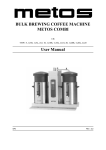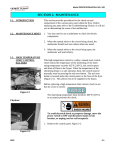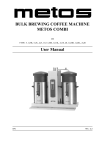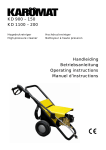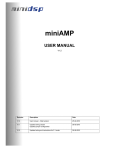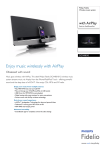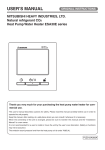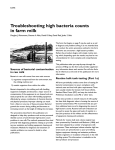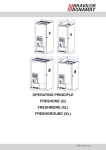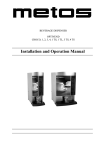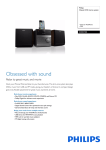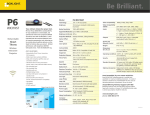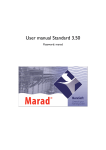Download BULK BREWING COFFEE MACHINE METOS COMBI User Manual
Transcript
BULK BREWING COFFEE MACHINE
METOS COMBI
CBW
TYPE: 5W, 1x5WR, 1x5WL, 2x5W, 10W, 1x10WR, 1x10WL, 2x10W, 20W, 1x20WR,
1x20WL, 2x20W
User Manual
S/N:
Rev.: 2.2
13.5.2011
Rev. 2.2
Dear Customer,
Congratulations on deciding to choose a Metos appliance for your kitchen activities. You
made an excellent choice. We will do our best to make you a satisfied Metos customer
like thousands of customers we have around the world.
Please read this manual carefully. You will learn correct, safe and efficient working methods in order to get the best possible benefit from the appliance. The instructions and hints
in this manual will give you a quick and easy start, and you will soon note how nice it is
to use the Metos equipment.
All rights are reserved for technical changes.
You will find the main technical data on the rating plate fixed to the equipment. When you
need service or technical help, please let us know the serial number shown on the rating
plate. This will make it easier to provide you with correct service.
For your convenience, space is provided below for you to record your local Metos service
contact information.
METOS TEAM
Metos service phone number:...............................................................................................
Contact person:....................................................................................................................
13.5.2011
Rev. 2.2
13.5.2011
Rev.
1. General .......................................................................................................... 1
1.1 Symbols used in the manual .......................................................................................... 1
1.2 Symbols used on the appliance ...................................................................................... 1
1.3 Checking the relationship of the appliance and the manual .......................................... 1
2. Safety .............................................................................................................. 2
2.1 Warnings ........................................................................................................................
2.1.1 Installation .............................................................................................................
2.1.2 Use .........................................................................................................................
2.1.3 Maintenance and troubleshooting ..........................................................................
2.2 Safeguards .....................................................................................................................
2.2.1 On/off switch .........................................................................................................
2.2.2 STOP button ..........................................................................................................
2.2.3 Swivel arm and container detection .......................................................................
2.2.4 Dry-boil protection ................................................................................................
2.2.5 Warning indication display ....................................................................................
2.3 Disposal of the appliance ...............................................................................................
2
2
2
2
3
3
3
3
3
3
4
3. Functional description .................................................................................. 5
3.1 General .......................................................................................................................... 5
3.2 Models ........................................................................................................................... 5
3.3 Application of the appliance .......................................................................................... 6
3.3.1 Prohibited use/Use for other purposes ................................................................... 6
3.4 Construction [1x5W, 1x10W, 1x20W, 2x5W, 2x10W, 2x20W] ................................. 7
3.5 Contruction [5W, 10W, 20W] ...................................................................................... 9
3.6 Operating switches and indicator lights ..................................................................... 11
3.7 Display ........................................................................................................................ 12
3.8 Error reporting symbols ............................................................................................... 12
4. Operation instructions ............................................................................... 13
4.1 Before using the appliance ..........................................................................................
4.1.1 Flushing the flow heater system ..........................................................................
4.1.2 Flushing the boiler system ...................................................................................
4.1.3 First settings operator menu .................................................................................
4.2 Operation procedures ...................................................................................................
4.2.1 Brewing coffee .....................................................................................................
4.2.2 Brewing tea ..........................................................................................................
4.2.3 Timer function .....................................................................................................
4.2.4 Drawing off hot water [1x5W, 1x10W, 1x20W, 2x5W, 2x10W, 2x20W] ........
4.2.5 Drawing off hot water [5W, 10W, 20W] ............................................................
13
13
14
14
14
16
17
18
19
21
13.5.2011
4.2.6 Temperature protection ........................................................................................
4.2.7 The operator menu ..............................................................................................
4.2.8 Menu functions ....................................................................................................
4.2.9 Settings step by step .............................................................................................
4.3 After use ......................................................................................................................
4.3.1 Cleaning ..............................................................................................................
4.3.2 Periodic descaling activities .................................................................................
Rev.
22
22
23
24
45
45
48
5. Installation ................................................................................................... 49
5.1 General ........................................................................................................................ 49
5.2 Unpacking [1x5, 1x10, 1x20, 2x5, 2x10, 2x20, 1x5W, 1x10W, 1x20W, 2x5W, 2x10W,
2x20W] .............................................................................................................................. 50
5.3 Unpacking [5W, 10W, 20W] ....................................................................................... 51
5.4 Preparation for positioning .......................................................................................... 51
5.5 Water connection ......................................................................................................... 52
5.5.1 Water treatment ....................................................................................................
5.6 Water drainage .............................................................................................................
5.7 Electrical connection ...................................................................................................
5.8 Connection on a counter ..............................................................................................
5.9 Mounting on a wall [5W, 10W, 20W] .........................................................................
52
52
53
54
54
6. Troubleshooting .......................................................................................... 56
7. Technical specifications .............................................................................. 57
13.5.2011
Rev. 2.2
General
1.
General
Carefully read the instructions in this manual as they contain important information regarding proper, efficient and safe installation, use and maintenance of the appliance.
Keep this manual in a safe place for eventual use by other operators of the appliance.
The installation of this appliance must be carried out in accordance with the manufacturer’s instructions and following local regulations. The connection of the appliance to the
electric and water supply must be carried out by qualified persons only.
Persons using this appliance should be specifically trained in its operation.
Switch off the appliance in the case of failure or malfunction. The periodical function
checks requested in the manual must be carried out according to the instructions. Have the
appliance serviced by a technically qualified person authorized by the manufacturer and
using original spare parts.
Not complying with the above may put the safety of the appliance in danger.
1.1
Symbols used in the manual
This symbol informs about a situation where a safety risk might be at hand. Given instructions are mandatory in order to prevent injury.
This symbol informs about the right way to perform in order to prevent bad results, appliance damage or hazardous situations.
This symbol informs about recommendations and hints that help to get the best performance out of the appliance.
This symbol informs about a function that has to be taken into account in self-control.
1.2
Symbols used on the appliance
This symbol on a part informs about electrical terminals behind the part. The removal of
the part must be carried out by qualified persons only.
1.3
Checking the relationship of the appliance and the manual
The rating plate of the appliance indicates the serial number of the appliance. If the manuals are missing, it is possible to order new ones from the manufacturer or the local representative. When ordering new manuals it is essential to quote the serial number shown
on the rating plate.
1
13.5.2011
Rev. 2.2
Safety
2.
Safety
2.1
Warnings
2.1.1
Installation
•
•
•
•
•
•
•
•
•
2.1.2
Use
•
•
•
•
•
•
•
•
2.1.3
Inspect the appliance before using it and check it for damage.
Never submerge or spray the appliance.
Do not press the buttons with a sharp object.
Protect the controls against dirt and grease.
During use some parts will become very hot.
Do not position the container on open fire, or hot plate.
First disconnect the electric cable before transporting the container.
It is advisable to take the plug out of the socket and close the water tap if the appliance is not going to be used for longer periods of time
Maintenance and troubleshooting
•
•
•
2
Place the appliance at buffet height and on a firm, level base, in such a way that it
can be connected to the water supply and power supply.
Connect the appliance to an earthed wall socket.
Position the appliance in such a way that no damage can be caused if it leaks.
Do not tilt the appliance, always position and move the appliance upright.
Connect an overflow pipe to the drainage tube.
Water always remains in the heating system: for this reason the appliance must not
be placed in an area where the temperature can fall below freezing point.
When installing the appliance, always observe the local rules and use approved
materials and parts.
The Installation chapter must again be followed when repositioning the appliance.
Connect the appliance to the cold water mains.
Observe the descaling intervals indicated by the descaling indicator symbol.
Overdue maintenance to the heating system can result in high repair costs and annulment of the guarantee.
Do not leave the appliance unattended when maintenance is being performed.
13.5.2011
Rev. 2.2
Safety
•
•
•
•
2.2
When descaling the appliance, it is advisable to wear safety glasses and protective
gloves.
Wash your hands after descaling.
Have all repairs carried out by a qualified technician.
The plug must be taken out of the socket if the appliance has to be opened for
cleaning or repairs.
Safeguards
The appliance is fitted with the following safe guards
2.2.1
On/off switch
The on/off switch is used to switch the appliance on and off. Remember that the appliance
can still be live after being switched off! For this reason you should always remove the
plug from the socket to render the appliance voltage-free.
2.2.2
STOP button
The coffee making process can be interrupted at any point using the STOP button located
on the control panel.
2.2.3
Swivel arm and container detection
This appliance is equipped with a safety device through which it is only possible to start
the brewing process if the swivel arm and container are in the correct position. If the swivel arm and/or container are moved out of position during the brewing process, the brewing
process is interrupted, a swivel arm and/or container symbol appears in the display and
there is a sound signal (2x short). Once the positioning fault has been resolved the brewing
process can be restored by pressing the START button.
2.2.4
Dry-boil protection
This appliance is equipped with a dry-boil protection. This protection triggers if the heating elements overheat owing to a fault. Once the fault has been resolved, the dry-boil protection can be reset at the outside of the appliance. The most common cause of the dryboil protection being triggered is not descaling the heating system in time.
2.2.5
Warning indication display
A technical fault is reported by displaying an error code in the display. The relevant problem can be localised and resolved with the help of this code. In this case see chapter 13Troubleshooting.
3
13.5.2011
Rev. 2.2
Safety
2.3
Disposal of the appliance
No appliance lasts forever. When the time comes to discard your appliance it will usually
be possible to return it to your dealer. If this is not the case, ask your municipal council
about the alternatives for recycling the materials. All plastic parts have been given standard codes. The parts of the appliance such as the printed circuit board and accompanying
parts form electrical and electronic waste. The metal body is made of stainless steel and
can be completely dismantled.
4
13.5.2011
Rev. 2.2
Functional description
3.
Functional description
3.1
General
The ComBi-line 5 - 20 is a professional coffee maker, equipped with a continuous flow
heater. It is very easy to use. The user can choose from a number of fixed set amounts via
a control panel with a graphic display which also offers information about the current
process of the appliance. Specific requirements and wishes concerning brewing quantity,
etc. can be accessed and programmed by the operator via a PIN. The operator also has the
possibility of reading counters and activating a descaling program.
3.2
Models
This manual covers the following coffeemakers of the ComBi-line range:
5
13.5.2011
Rev. 2.2
Functional description
3.3
3.3.1
Application of the appliance
Prohibited use/Use for other purposes
This machine can only be used for brewing and distributing coffee and/or tea. The use of
the appliance for other purposes is not permitted and may be hazardous. The manufacturer
cannot be held liable for losses caused by using the appliance for purposes other than
those indicated here or by incorrect use.
6
13.5.2011
Rev. 2.2
Functional description
3.4
Construction [1x5W, 1x10W, 1x20W, 2x5W, 2x10W, 2x20W]
7
13.5.2011
Functional description
1.
Socket L/R for container heating
2.
ON/OFF switch coffee system
3.
Hot water tap
4.
Drip tray with grid
5.
Base plate
6.
Control panel
6.1
On/Off button boiler system
6.2
STOP button / Back button (without changing)
6.3
Illuminated display
6.4
Selection button brew volume 1
6.5
Selection button brew volume 2
6.6
Selection button brew volume 3
6.7
Selection button brew volume 4
6.8
START button / Accept button (save)
6.9
Timer button
6.10 On/Off button container heating L/R
8
7.
Vapor escape opening boiler system
8.
Dry-boil protection
9.
Swivel arm
10.
Descale filling opening coffee brewing system
11.
Descale filling opening boiler system
12.
Insulated lid
13.
Blender - transport disk
14.
Dry-boil protection hot water system
15.
Water distributor lid
16.
Basket filter
17.
Integrated gauge glass
18.
Handle
19.
Coffee tap
20.
Socket with splash protection
21.
Pilot light
22.
Drain hose coffee brewing system
23.
Drain hose hot water system
Rev. 2.2
13.5.2011
Rev. 2.2
Functional description
3.5
Contruction [5W, 10W, 20W]
9
13.5.2011
Functional description
1.
Socket L/R for container heating
2.
ON/OFF switch coffee- and boiler system
3.
Hot water tap
4.
Drip tray with grid
5.
Wall bracket
6.
Control panel
6.1
On/Off button boiler system
6.2
STOP button / Back button (without changing)
6.3
Illuminated display
6.4
Selection button brew volume 1
6.5
Selection button brew volume 2
6.6
Selection button brew volume 3
6.7
Selection button brew volume 4
6.8
START button / Accept button (save)
6.9
Timer button
6.10 On/Off button container heating L/R
10
7.
Vapor escape opening boiler system
8.
Dry-boil protection coffee brewing system
9.
Swivel arm
10.
Descale filling opening coffee brewing system
11.
Descale filling opening boiler system
12.
Dry-boil protection hot water system
13.
Drain hose coffee brewing system
14.
Drain hose hot water system
Rev. 2.2
13.5.2011
Rev. 2.2
Functional description
3.6
Operating switches and indicator lights
A
Selection buttons (4x) The selection buttons
are used to select the standard brewing
amount. The chosen amount confirmed using the display and can be increased or decreased using the same selection buttons, as
required.
B
STOP buttonUse the STOP button to cancel
a selection or to (emergency) stop a process.
An emergency stop results in the process being lost,so it must be executed again. This
button can also be used as a cancellation button if theoperator menu is activated.
C
Boiler button Use the hot water button to
switch on the hot water system. After being
switched on, a tapsymbol appears at the top
of the display. The hot water system can be
switched off again using the same button.
D
DisplayThe display informs the user about
the status of the most important functions of
the appliance.
E
START buttonUse the START button to
start a brewing process. First choose the
brewing amount with one of the selection
buttons. This buttoncan also be used as a
confirmation button if the operator menu is
activated.
F
Timer buttonUse the timer button to program the brewing process for use at a later
point of time.
G
Container heating buttons (2x)Use the container heating button to switch the power
sockets that are on the side of the column
ON/OFF. ATTENTION: Only usethe power
sockets for the container heating, do not connect any other electrical appliances. (Maximum capacity 100W).
H
On/Off-switchThis switch is used to turn the
coffee making system ON (I) or OFF (0).
I
Power socket
11
13.5.2011
Rev. 2.2
Functional description
3.7
Display
I
Boiler systemThe hot water system is switched
on. The tap symbol can be replaced by the actual boilertemperature display via the operator
menu.
J
Brew volume (4x)Each selection button (4x)
displays a pre-programmed brewing amount.
The amountscan be set completely as required
via the settings menu.
K
ClockReal time indicator
L
Timer; (flashing)The timer function is activated.
M
Scale indicatorOne of the systems must be descaled at the first opportunity. Look up 'descaling' in theoperator menu.
N
Swivel arm in positionThe swivel arm is in the
correct position above a filter. If the swivel arm
is moved away the symbol disappears from the
display.
O
Container in positionThe coffee container with
filter unit is in the correct position. If the container is taken away the symbol disappears from
the display.
P
Container heatingThe heating of the coffee container is switched on. If the heating is switched
offthe symbol disappears from the display.
Q
Leaking outThe dripping symbol is displayed if
the hot water dosing is stopped and the filter
unit is leaking.
3.8
Error reporting symbols
Container position failureThis symbol appears in the display if the coffee container gets out of
position during a brewing process. The arrow shows on which side the problem occurs.
Swivel arm not in positionThis symbol appears in the display if the swivel arm gets out of position
during a making process. The arrow shows on which side the problem occurs.
Swivel arm not in position for new brewing process This symbol appears in the display if a brewing process is started and there is (still) no swivel arm in position above the filter unit.
Press START buttonThis symbol appears after the swivel arm and/or container fault has been resolved. For your own safety the start button must always be pressed again. If this report is responded to within 10 minutes the brewing process will restart and be completed.
If the START button is pressed only after 10 minutes, a cross symbol with a flashing clock appears in order to indicate that the brewing process can no longer be restored and should be considered lost.
12
13.5.2011
Rev. 2.2
Operation instructions
4.
Operation instructions
4.1
Before using the appliance
When used for the first time the appliance works according to the standard factory settings.
The various settings can be altered by trained, authorized personnel. See “Operator
menu”.
This chapter will explain the coffee brewing and hot water system process.
•
•
4.1.1
when the appliance is used for the first time.
when the appliance has not been used for more than 1 week, for example after a
holiday period.
Flushing the flow heater system
1.
2.
3.
4.
5.
6.
7.
8.
Open the water tap and check if the swivel connections are not leaking.
Put the cable with inlet plug into the back of the container and insert the plug into
the socket of the flow water heater (fig. 1-1).
Check if the containers are positioned correctly, with a filter unit (still without coffee), and position the swivel arm above the centre of the filter.
Switch the appliance on by putting the ON/OFF switch (fig. 1-2) in position I, the
display (fig. 1-5.2)lights up and you will hear a beeping sound. Then the display
will indicate the standard choices.
Press selection button 2 (fig. 1-5.4) and confirm your choice by pressing the
START button (fig. 1-5.7). The coffee system starts filling and the brewing process starts. In the display appears the text: BREWING. With the STOP button
(fig.1-5.1) the brewing process can be interrupted at any moment. When the watersupply stops coming out of the swivel arm, you will hear a beeping sound (1x
short). In the display appears the text: LEAKING. The leaking time is set as standard to approx. 5 minutes, and its ending is indicated by a beeping sound (3x short).
Empty the container with the drainage tap (fig. 1-15).
Position the swivel arm above the other filter and follow the above procedure once
again if the model is equipped with two containers.
Once the container is empty the coffee maker is ready for use.
13
13.5.2011
Rev. 2.2
Operation instructions
4.1.2
Flushing the boiler system
•
•
•
Switch on temperature indication in display (See “Show temperature” (menu 4.1)
Change temperature (“Temperature” (menu 4.2))
Switch on the continuous heating function 97+ (See Switch on the continuous
heating function 97°C+)
The hot water system steam outlet can be found on the top of the tower. Steam can escape
through this opening during normal heating and heating with the continuous heating function (97°C+) switched on! Do not touch the moisture outlet. There is a danger of burning.
•
•
•
•
4.1.3
Press the hot water system on/off button (
). The hot water system fills itself
automatically, and then heats up. A flashing tap symbol appears in the display.
The tap symbol stops flashing when the hot water system is hot enough (90°C).
The hot water system can be switched off at any moment by pressing the on/off
button again (
). The tap symbol disappears from the display and the system
will no longer refill or heat up.
Draw off approx. 2 litres of water using the no-drip tap (fig. 1-3) and throw it away.
The hot water system fills itself automatically with fresh water.
The boiler system is now ready for use.
First settings operator menu
The following details are set in the operator menu immediately after being used for the
first time. Please note: The default language setting is English. To gain access to the operator menu system settings see chapter “The operator menu”.
System settings (Systeminstellungen) (menu 2)
2.0
Language
2.1
Time
2.2
Date
Coffee settings (menu 3)
4.2
3.9
Descale indicator
3.10
Coffee dosing
Operation procedures
This chapter describes the daily use of the appliance by partly qualified personnel. When
the machine is used for the first time, it works in accordance with the standard factory settings. The different settings can be changed later by trained, qualified personnel. See “The
operator menu” for more details.
Inspect the appliance before using it and check it for damage.
Never submerge or spray the appliance.
Do not press the buttons with a sharp object.
Protect the controls against dirt and grease.
14
13.5.2011
Rev. 2.2
Operation instructions
During use some parts will become very hot.
Do not position the container on open fire or on a hotplate.
First disconnect the electric cable before transporting the container.
It is advisable to take the plug out of the socket and close the water tap if the appliance is
not going to be used for longer periods of time.
Preparations
•
•
•
Put the cables with inlet plug into the back of the container and insert the plug into
the socket of the flow water heater (fig. 1-1).
The inner pot of the container must always be fresh and clean.
Place the coffee blender into the container. The blender guarantees a uniform quality of the coffee, which makes stirring the coffee (with loss of time, temperature
and aroma) unnecessary. The temperature of the coffee is kept at a temperature of
80-85°C. The storage time of the coffee is determined by the blend of coffee and
is usually 1 à 1,5 hours.
Basic rules for brewing coffee
•
•
Use regular ground coffee (±50 gram/liter)
Keep the inner pot, filter unit and the mixer
clean.
Tip: always keep the basket filter paper in the original packing!
•
•
A
This means the paper keeps its original (basket) shape.
This prevents the paper from collapsing or
not fitting in the filter.
Filter lid with water distributor
B
Basket filter paper
C
Basket filter
D
Blender
E
Insulated lid
F
Container
15
13.5.2011
Rev. 2.2
Operation instructions
4.2.1
Brewing coffee
Switch on the appliance by putting the ON/OFF
switch (
) in position I, the display lights up and
you will hear a beeping sound (1x short). Then the
display indicates the standard brewing amounts.
Select one of the four brewing amounts.
The selected brewing amount including a recommended coffee dosage appears in the display. Tip: If
you do not want the selected brewing amount, you
can increase/decrease it with the + or - button. The
recommended coffee dosage changes accordingly.
Place a basket filter paper in the basket filter and fill
it with the recommended brewing amount of coffee
(standard ground). Spread the coffee evenly in the
filter and then put the filter lid on.
Place the filter unit on the container and position the
swivel arm above the centre of the filter.
Press the START button (
) to start the brewing
process. In the display appears the text: Processing.
The container heating switches on automatically,
the heating should be switched off manually (
)
if the container is empty. During the coffee brewing
process, the display shows the selected brewing
amount (below) and the amount of water already
gone through the filter (above).
When the water supply stops coming out of the
swivel arm you will hear a beeping sound (1x
short). In the display appears the text: Leaking out.
The leak out time is set as standard to approx. 5
minutes, and its ending is indicated by a beeping
sound (3x short).
Remove the synthetic filter after it has been used
and put the insulated lid on the container.
Clean the synthetic filter.
After the brewing process you can draw off a cup of coffee by using the no-drip tap on the
container.
16
13.5.2011
Rev. 2.2
Operation instructions
Tip
•
•
•
4.2.2
If the swivel arm and/or the container are moved out of position before and/or during the brewing process, the brewing process will stop, a swivel arm and/or container symbol will appear in the display and you will hear a beeping signal (2x
short). Once the positioning fault has been resolved the brewing process can be restored by pressing the START button (
) . See “Error reporting symbols”.
The brewing process can be interrupted at any moment with the STOP button
(
). The brewing process should then be considered as lost.
Prepare another brewing process by getting the second synthetic filter ready if required. Once the water supply has stopped coming from the swivel arm, you canposition the swivel arm above the other filter and start a new brewing process
immediately. The dripping symbol from the 1st container will then disappear.
Brewing tea
For the preparation of tea you can follow the same steps as the ones described for the coffee brewing process. However, instead of using a coffee making unit, you should use a tea
filter and disk (optional).
1.
2.
3.
4.
5.
6.
7.
1. Put the tea, loose or in bags, in the tea filter approximately 6 grams per liter.
nsert the tea filter into the disk (B) already placed
in the container.
Place the filling pipe (A) on the tea filter. Then position the swivel arm over the pipe.
Select the brewing quantity and start the brewing
process.
Remove the pipe and the tea filter after the tea has
been made. ATTENTION: the filling pipe and filter are HOT!
After brewing put the insulated lid on the container
to avoid loss of temperature and taste.
Clean the tea filter immediately after use.
A
Filling pipe
B
Tea filter with disk
C
Container with lid
The optimum extraction time is minimally 4 minutes and maximally 15 minutes. After
more than 15 minutes the flavor of the tea deteriorates.
17
13.5.2011
Rev. 2.2
Operation instructions
4.2.3
Timer function
The appliance comes with a built-in timer clock as standard. You can use this to start a
coffee brewing process and/or hot water system at a certain time.
Press the timer button (
).The following possible
settings (fig. 9A) appear in the display. Select the
system you want to switch on automatically. Use the
selection arrows for this. Tap = hot water system.
Container = coffee brewing system. Confirm your
choice with the START button (
)
Set the required start time (day/hour/min) with the
left and right selection buttons (fig. 9A) and confirm
your setting with the START button(
). The day
automatically moves to the next day when the hour
setting goes past 24:00. Confirm your choice with
the START button (
)
Select the required brewing quantity (fig. 9B) and
confirm your choice with the START button
The display shows.
Place a basket filter paper in the basket filter and fill
it with the recommended brewing amount of coffee
(standard ground) as shown in the display. Spread the
coffee evenly in the filter and put the filter lid on.
Then place the filter unit on the container, and position the swivel arm above the centre of the filter.
Check if the container is empty. Confirm your choice with the START button .
Explanation of the display:
•
•
•
•
Clock symbol (flashing): timer clock is activated
The brewing quantity, start time and day are
displayed.
Swivel arm/container symbol: The coffee
maker is ready.
The appliance may NOT be switched off!
Tip
•
18
The timer clock function can only be cancelled by pressing the STOP button .
13.5.2011
Rev. 2.2
Operation instructions
•
•
4.2.4
The container heating switches on automatically 5 minutes before the set time
(pre-heating). The coffee brewing process is switched off during an activated timer
clock function. The container heating can be used normally, for example, to keep
the coffee on the left warm, while on the right the coffee brewing process is preprogrammed.The timer can be programmed a maximum of 6 days inadvance. This
enables you to bridge a long weekendeasily.
The swivel arm and container safety devices remain active. If the swivel arm
moves out of position, for example, it is detected immediately and a warning symbol appears in the display followed by a beeping sound (2x short). Once the swivel
arm is moved back to the correct position, the timer clock is active again.
Drawing off hot water [1x5W, 1x10W, 1x20W, 2x5W, 2x10W, 2x20W]
The appliance comes with a separate hot
water system with a no-drip tap (A)
through which it is possible to draw off
hot water during the coffee brewing process.
The hot water system steam outlet can be
found on the top of the column (B).
Steam can escape through this opening
during normal heating and during heating
with the continuous heating function
(97°C+) switched on! Do not touch the
moisture outlet. There is a risk of burning.
1.
2.
3.
•
•
•
Press the hot water system on/off
button (B). The hot water system fills automatically, before heating up. A flashing tap symbol
appears in the display (A).
The tap symbol stops flashing when the hot water system is hot enough.
The hot water system is now ready for use.
The hot water temperature is set to 90°C as
standard.
The hot water system can be switched off at
any moment by pressing the on/off button
again (B). The tap symbol disappears on the
display and the system will no longer refill or
heat up.
If a large amount of hot water is drawn off the
boiler fills and heats in charges of approx. 0.75
litres. This means you have (some) hot water
again in a short time.
19
13.5.2011
Rev. 2.2
Operation instructions
Have you not used the appliance for more than 1 week? If so, use the appliance as described in chapter “Before using the appliance”. After carrying out these actions the whole
hot water system has been refreshed. This all contributes to the provision of good quality
coffee and/or hot water.
20
13.5.2011
Rev. 2.2
Operation instructions
4.2.5
Drawing off hot water [5W, 10W, 20W]
The appliance comes with a separate hot water
system with a no-drip tap (A) through which it is
possible to draw off hot water during the coffee
brewing process.
The hot water system steam outlet can be found
on the top of the column (B). Steam can escape
through this opening during normal heating and
during heating with the continuous heating function (97°C+) switched on! Do not touch the moisture outlet. There is a risk of burning.
1.
2.
3.
•
•
•
Press the hot water system on/off button
(B). The hot water system fills automatically,
before heating up. A flashing tap symbol appears in the display (A).
The tap symbol stops flashing when the hot water system is hot enough.
The hot water system is now ready for use.
The hot water temperature is set to 90°C as
standard.
The hot water system can be switched off at
any moment by pressing the on/off button
again (B). The tap symbol disappears on the
display and the system will no longer refill or
heat up.
If a large amount of hot water is drawn off the
boiler fills and heats in charges of approx. 0.75
litres. This means you have (some) hot water
again in a short time.
Have you not used the appliance for more than 1 week? If so, use the appliance as described in chapter “Before using the appliance”. After carrying out these actions the whole
hot water system has been refreshed. This all contributes to the provision of good quality
coffee and/or hot water.
21
13.5.2011
Rev. 2.2
Operation instructions
4.2.6
Temperature protection
There temperature protection in the unit (fig. 1-6) that can be accessed from the outside.
The protection switch off when the temperatures rise too high. The most common cause
for switching off is scale that has not been removed in time. If the temperature protection
operates proceed as follows:
•
•
•
Let the unit cool down.
Unscrew the black protection cover.
Push the button that now appears and replace the black cover tightly.
If the protection was triggered due to scale formation, then proceed according to “Descaling”. If scale formation was not the cause, then contact your dealer.
4.2.7
The operator menu
This chapter describes how the different settings
can be changed by trained, qualified personnel. To
gain access to the operator menu, read below.
Once in the operator menu the control panel has
the following functions:
22
Button
selection arrow
up
Button
selection arrow
down
Button
back (without saving changes)
Button
accept (activate)
13.5.2011
Rev. 2.2
Operation instructions
4.2.8
Menu functions
You have the possibility of changing settings and have access to a number of maintenance
functions via the operator menu. It is possible to select the following functions:
Menu Explanation of Operator menu
0
Counters
1
Descaling
2
System settings
3
Coffee settings
4
Hot water settings [W]
Getting access to the operator menu
1.
2.
3.
4.
5.
6.
Switch the appliance off (0)
Hold the START button (
) and switch on
(I) the ON / OFF switch (
).
Release the START button when the display
lights up. In the display appears: Operator
menu. Press any button
Press any button. In the display appears: Enter PIN: _ _ _ _ _
Look up the associated 5 digit PIN and enter
it using the numbered buttons in the display
(5.3 to 5.6). Please note: the code number is
produced at random, so the PIN is always
different!
After entering the PIN the Operator menu
will light up in the display.
Scrolling through the menu and activating the functions
•
•
•
Move the arrow
to the required menu item using the selection buttons
You activate the required menu by using the START button
.
By pressing the STOP button
you go back to the previous screen without saving the changes made.
Confirm a change by pressing the START button
sound.
. You will hear a short beeping
Closing the operators menu:
1.
2.
Press the STOP button
until the user menu reappears.
Check if the changed settings are as required. If the settings are not as required,follow the procedure again.
While you are in the settings menu the appliance will not fill or heat up
23
13.5.2011
Rev. 2.2
Operation instructions
4.2.9
Settings step by step
Counters (Menu 0)
PIN
Counters
then select the counter item
An overview of all counter functions follows in the
display. At the top of the display is a navigation bar
on which the selected menu item number is shown.
Menu Explanation of Operator menu
0.0
Daily counter of coffee made in litres
0.1
Reset daily counter of coffee made
0.2
Total counter of coffee made in litres
0.3
Daily counter of used hot water in litres
0.4
Reset daily counter of used hot water
0.5
Total counter of used hot water in litres
1.
2.
Select the required counter, and confirm with the START button
Read the counter reading or reset the counter as required.
.
Descaling (Menu 1) [1x5W, 1x10W, 1x20W, 2x5W, 2x10W, 2x20W]
PIN
Descaling
then select function
An overview of all descaling functions follows in
the display. At the top of the display is a navigation
bar on which the selected menu function number is
shown.
Menu Explanation of Operator menu
1.0
Flow counter
1.1
Start flow counter
1.2
Hot water counter
1.3
Start hot water program
Flow counter (Menu 1.0)
After activating the flow counter you can read how many litres away from a descaling signal the coffee maker is. Example: The diagram opposite indicates that the coffee making
part (flow system) is still 961 litres away from a descaling signal. The counters are automatically reset after the relevant descaling program has been run.
Warnings
•
•
•
•
•
24
Respect the descaling intervals indicated by the descale indicator symbol.
Delaying maintenance of the heating system can lead to high repair costs and can
invalidate the guarantee.
When descaling, always pay attention to the directions on the scale remover.
Keep up with the maintenance requirements for the appliance
It is advisable to wear safety glasses and protective gloves when descaling.
13.5.2011
Rev. 2.2
Operation instructions
•
•
•
Wash your hands thoroughly after descaling.
All repairs should be carried out by a trained, competent service engineer.
The plug must always be pulled out of the power socket whenever the appliance
has to be opened for repairs and other (cleaning) purposes.
Starting the coffee maker descaling program (Menu 1.1)
Preparation
•
•
•
•
Move the swivel arm above an empty container
and synthetic filter.
Brew the smalles brewing amount (without coffee) once. The advantage of this is that the element is well preheated, so that descaling is
better and takes less time.
Carefully read the caution notice and the directions on the sachet Animo scale remover.
Dissolve 2 sachets of 50 gram Animo scale remover into 2 litre of warm water (60°C). Stir the
solution thoroughly so that the powder is completely dissolved.
Remove the filter and place a plastic container under
the outlet of the swivel arm to collect the scale remover.
•
Follow the instructions shown on the display
and confirm each action with
.
Display: 1/5 Place measuring cup. Press start
.
25
13.5.2011
Rev. 2.2
Operation instructions
Stopping the program
The program can be cancelled at any time until the solution is poured in. Once the solution
has been poured in, the program must always
be completed. In case of an emergency stop,
the STOP button can always be used. The
program will then stop, but not be finished.
•
•
•
•
•
Remove the cap from the descaling
opening left of the swivel arm.
Insert the descaling funnel (A) into the
descaling opening. Push the funnel
downward as far as possible.
Slowly pour the scale remover into the
funnel. The scale remover will enter
the boiler element by the supply pipe
and will come out of the swivel arm as
foam.
Repeat the procedure described above
if there is a grat amount of foam.
Press the START button
to continue the programm.
Display: 2/5 <- funnel left. Pour solution
through. Ready? Press start
.
The program is now ready to flush the system
3 times, so that the remaining scale remover can be removed from the heating system. Remove the funnel and replace the cap. Remove the plastic container with the collected scale
remover and replace the filter.
Display: 2/5 Remove funnel. Place filter. Press Start
Display: 3/5 Rinse. Press Start
Press the START button
.
to start the 1st rins cycle.
Display: 3/5 Rinse. Please wait.The coffee maker will heat up.
The container will be filled with 2 litres. There will be 3 beeping signals after the 1st rinsing cycleDisplay: 3/5 Empty container. Press Start
.Once the container is empty press the
START button
.
26
13.5.2011
Rev. 2.2
Operation instructions
Display: 4/5 Rinse. Press Start
Press the START button
.
to start the 2nd rinsing cycle.
Display: 4/5 Rinse. Please wait.The coffee maker will heat up.
The container will be filled with 2 litres. There will be 2 beeping signals after the 2nd rinsing cycle.Display: 4/5 Empty container. Press Start
.
Once the container is empty press the START button
Display: 5/5 Rinse. Press Start
Press the START button
.
.
to start the 3rd rinsing cycle.
Display: 5/5 Rinse. Please wait.The coffee maker will heat up.
The container will be filled with 2 litres. There will be 3 beeping signals after the 3rd rinsing cycle.
Display: 5/5 Empty container. Press Start
.
Once the container is empty press the START button
.
The descaling program is now complete and the descaling
menu will reappear in the display. The flow counter will automatically be reset to the starting value. Exit the menu by pressing the STOP button
twice, or select another menu
function.
Hot water counter menu (Menu 1.2)
After activating the hot water counter 1.2 you can read how many litres away from a hot
water signal the coffee maker is.
Start descaling menu for hot water system (Menu 1.3)
Preparation
•
•
•
Read the warnings and user guide on the sachets of the Animo scale remover first.
Dissolve 2 x 50g sachets of Animo scale remover in 1 litre of warm water (60°C).
Stir the solution thoroughly so that the powder is completely dissolved.
Follow the instructions shown on the display and confirm each action with .
The hot water system must be drained completely empty a number of times during the
descaling procedure. Use the drainage hose from under the foot plate for this (fig. 1-23).
If necessary turn the furthest away closing tap open carefully and let water run in to one
bucket. Careful; the water is hot!
27
13.5.2011
Operation instructions
Display: 1/5 Empty boiler. Press Start.
Empty the boiler with the hot water drainage tap (fig.
1-3). Drain the remaining water off with the drainage
hose (fig. 1-23 ), the boiler is now completely empty.
Once the boiler is empty press the START button
. (if a double beeping signal sounds the boiler is
not completely empty).
Display: 2/5 Funnel right -> Add solution. Press Start.
Remove the cap from the opening on the right, next to
the swivel arm (fig. 1-11). Place the supplied funnel
in the opening and pour the descaling solution slowly
in the funnel. Once all the descaling solution has been
poured, press the START button
.
Display: 2/5 Filling / heating up. Please wait.
The boiler fills and heats up, the descaling solution is
distributed. When the boiler has reached a certain
temperature a beeping signal sounds.
Display: 2/5 Act solution. Wait approx. 5 min.
It now takes about 5 minutes for the descaling solution to
take effect on the limescale. When the waiting period is
over, 3 beeping signals will sound. The program is now
ready to be rinsed through 3 times so that the residue from
the descaling solution can be removed from the boiler.
Display: 2/5 Empty boiler. Press Start.
Empty the boiler with the hot water drainage tap (fig. 13). Drain the remaining water off with the drainage hose
(fig. 1-23 ).The boiler is now completely empty. Press the
START button
to start the 1st rinsing cycle. If a double beeping signal sounds the boiler is not completely
empty.
Display: 3/5 Filling. Please wait.
The boiler is filled completely, without heating up. There
will be 3 beeping signals after the 1st rinsing cycle.
Display: 3/5 Empty boiler. Press Start.
Empty the boiler with the hot water drainage tap (fig. 13). Drain the remaining water off with the drainage hose
(fig. 1-23 ).The boiler is now completely empty. Press the
START button
to start the 2nd rinsing cycle.
28
Rev. 2.2
13.5.2011
Rev. 2.2
Operation instructions
Display: 4/5 Filling. Please wait.
The boiler is filled completely, without heating up. There
will be 3 beeping signals after the 2nd rinsing cycle
Display: 4/5 Empty boiler. Press Start.
Empty the boiler with the hot water drainage tap (fig. 13). Drain the remaining water off with the drainage hose
(fig. 1-23 ).The boiler is now completely empty. Press the
START button
to start the 3rd rinsing cycle.
Display: 5/5 Filling. Please wait.
The boiler is filled completely, without heating up. There
will be 3 beeping signals after the 3rd (and final) rinsing
cycle
Display: 5 /5 Empty boiler. Press Start.
Empty the boiler with the hot water drainage tap (fig. 13). Drain the remaining water off with the drainage hose
(fig. 1-23 ).The boiler is now completely empty. Press the
START button
to start the 3rd rinsing cycle.
The descaling program is now complete and the descaling menu will reappear in the display. The flow counter will automatically be reset to the starting value. Exit the menu by
pressing the stop button twice, or select another menu function.
The hot water system is completely empty after the descaling, bring the system back into
use by switching on the hot water button on the control panel.
Descaling (Menu 1) [5W, 10W, 20W]
PIN
Descaling
then select function
An overview of all descaling functions follows in
the display. At the top of the display is a navigation
bar on which the selected menu function number is
shown.
Menu Explanation of Operator menu
1.0
Flow counter
1.1
Start flow counter
1.2
Hot water counter
1.3
Start hot water program
Flow counter (Menu 1.0)
After activating the flow counter you can read how many litres away from a descaling signal the coffee maker is. Example: The diagram opposite indicates that the coffee making
part (flow system) is still 961 litres away from a descaling signal. The counters are automatically reset after the relevant descaling program has been run.
29
13.5.2011
Rev. 2.2
Operation instructions
Warnings
•
•
•
•
•
•
•
•
Respect the descaling intervals indicated by the descale indicator symbol.
Delaying maintenance of the heating system can lead to high repair costs and can
invalidate the guarantee.
When descaling, always pay attention to the directions on the scale remover.
Keep up with the maintenance requirements for the appliance
It is advisable to wear safety glasses and protective gloves when descaling.
Wash your hands thoroughly after descaling.
All repairs should be carried out by a trained, competent service engineer.
The plug must always be pulled out of the power socket whenever the appliance
has to be opened for repairs and other (cleaning) purposes.
Starting the coffee maker descaling program (Menu 1.1)
Preparation
•
•
•
•
Move the swivel arm above an empty container
and synthetic filter.
Brew the smalles brewing amount (without coffee) once. The advantage of this is that the element is well preheated, so that descaling is
better and takes less time.
Carefully read the caution notice and the directions on the sachet Animo scale remover.
Dissolve 2 sachets of 50 gram Animo scale remover into 2 litre of warm water (60°C). Stir the
solution thoroughly so that the powder is completely dissolved.
Remove the filter and place a plastic container under
the outlet of the swivel arm to collect the scale remover.
•
Follow the instructions shown on the display
and confirm each action with
.
Display: 1/5 Place measuring cup. Press start
Stopping the program
30
.
13.5.2011
Rev. 2.2
Operation instructions
The program can be cancelled at any time until the solution is poured in. Once the solution
has been poured in, the program must always
be completed. In case of an emergency stop,
the STOP button can always be used. The
program will then stop, but not be finished.
•
•
•
•
•
Remove the cap from the descaling
opening left of the swivel arm.
Insert the descaling funnel (A) into the
descaling opening. Push the funnel
downward as far as possible.
Slowly pour the scale remover into the
funnel. The scale remover will enter
the boiler element by the supply pipe
and will come out of the swivel arm as
foam.
Repeat the procedure described above
if there is a grat amount of foam.
Press the START button
to continue the programm.
Display: 2/5 <- funnel left. Pour solution
through. Ready? Press start
.
The program is now ready to flush the system
3 times, so that the remaining scale remover can be removed from the heating system. Remove the funnel and replace the cap. Remove the plastic container with the collected scale
remover and replace the filter.
Display: 2/5 Remove funnel. Place filter. Press Start
Display: 3/5 Rinse. Press Start
Press the START button
.
to start the 1st rins cycle.
Display: 3/5 Rinse. Please wait.The coffee maker will heat up.
The container will be filled with 2 litres. There will be 3 beeping signals after the 1st rinsing cycleDisplay: 3/5 Empty container. Press Start
.Once the container is empty press the
START button
.
31
13.5.2011
Rev. 2.2
Operation instructions
Display: 4/5 Rinse. Press Start
Press the START button
.
to start the 2nd rinsing cycle.
Display: 4/5 Rinse. Please wait.The coffee maker will heat up.
The container will be filled with 2 litres. There will be 2 beeping signals after the 2nd rinsing cycle.Display: 4/5 Empty container. Press Start
.
Once the container is empty press the START button
Display: 5/5 Rinse. Press Start
Press the START button
.
.
to start the 3rd rinsing cycle.
Display: 5/5 Rinse. Please wait.The coffee maker will heat up.
The container will be filled with 2 litres. There will be 3 beeping signals after the 3rd rinsing cycle.
Display: 5/5 Empty container. Press Start
.
Once the container is empty press the START button
.
The descaling program is now complete and the descaling
menu will reappear in the display. The flow counter will automatically be reset to the starting value. Exit the menu by pressing the STOP button
twice, or select another menu
function.
Hot water counter menu (Menu 1.2)
After activating the hot water counter 1.2 you can read how many litres away from a hot
water signal the coffee maker is.
Start descaling menu for hot water system (Menu 1.3)
Preparation
•
•
•
Read the warnings and user guide on the sachets of the Animo scale remover first.
Dissolve 2 x 50g sachets of Animo scale remover in 1 litre of warm water (60°C).
Stir the solution thoroughly so that the powder is completely dissolved.
Follow the instructions shown on the display and confirm each action with .
The hot water system must be drained completely empty a number of times during the
descaling procedure. Use the drainage hose from under the foot plate for this (fig. 1-23).
If necessary turn the furthest away closing tap open carefully and let water run in to one
bucket. Careful; the water is hot!
32
13.5.2011
Rev. 2.2
Operation instructions
Display: 1/5 Empty boiler. Press Start.
Empty the boiler with the hot water drainage tap (fig.
1-3). Drain the remaining water off with the drainage
hose (fig. 1-23 ), the boiler is now completely empty.
Once the boiler is empty press the START button
. (if a double beeping signal sounds the boiler is
not completely empty).
Display: 2/5 Funnel right -> Add solution. Press Start.
Remove the cap from the opening on the right, next to
the swivel arm (fig. 1-11). Place the supplied funnel
in the opening and pour the descaling solution slowly
in the funnel. Once all the descaling solution has been
poured, press the START button
.
Display: 2/5 Filling / heating up. Please wait.
The boiler fills and heats up, the descaling solution is
distributed. When the boiler has reached a certain
temperature a beeping signal sounds.
Display: 2/5 Act solution. Wait approx. 5 min.
It now takes about 5 minutes for the descaling solution to
take effect on the limescale. When the waiting period is
over, 3 beeping signals will sound. The program is now
ready to be rinsed through 3 times so that the residue from
the descaling solution can be removed from the boiler.
Display: 2/5 Empty boiler. Press Start.
Empty the boiler with the hot water drainage tap (fig. 13). Drain the remaining water off with the drainage hose
(fig. 1-23 ).The boiler is now completely empty. Press the
START button
to start the 1st rinsing cycle. If a double beeping signal sounds the boiler is not completely
empty.
Display: 3/5 Filling. Please wait.
The boiler is filled completely, without heating up. There
will be 3 beeping signals after the 1st rinsing cycle.
Display: 3/5 Empty boiler. Press Start.
Empty the boiler with the hot water drainage tap (fig. 13). Drain the remaining water off with the drainage hose
(fig. 1-23 ).The boiler is now completely empty. Press the
START button
to start the 2nd rinsing cycle.
33
13.5.2011
Rev. 2.2
Operation instructions
Display: 4/5 Filling. Please wait.
The boiler is filled completely, without heating up. There
will be 3 beeping signals after the 2nd rinsing cycle
Display: 4/5 Empty boiler. Press Start.
Empty the boiler with the hot water drainage tap (fig. 13). Drain the remaining water off with the drainage hose
(fig. 1-23 ).The boiler is now completely empty. Press the
START button
to start the 3rd rinsing cycle.
Display: 5/5 Filling. Please wait.
The boiler is filled completely, without heating up. There
will be 3 beeping signals after the 3rd (and final) rinsing
cycle
Display: 5 /5 Empty boiler. Press Start.
Empty the boiler with the hot water drainage tap (fig. 13). Drain the remaining water off with the drainage hose
(fig. 1-23 ).The boiler is now completely empty. Press the
START button
to start the 3rd rinsing cycle.
The descaling program is now complete and the descaling menu will reappear in the display. The flow counter will automatically be reset to the starting value. Exit the menu by
pressing the stop button twice, or select another menu function.
The hot water system is completely empty after the descaling, bring the system back into
use by switching on the hot water button on the control panel.
System settings (menu 2)
PIN
System settings
then select function
An overview of all system settings follows in the
display. At the top of the display is a navigation bar
on which the selected menu function number is
shown.
Menu Explanation of Operator menu
34
2.0
Language
2.1
Time
2.2
Date
2.3
Sound signal
13.5.2011
Rev. 2.2
Operation instructions
Language (Menu 2.0)
Before using the appliance you must first set the desired language. The default language setting is English. Select the required language, and confirm your
changes with the START button
. Tip!: If Menu
4-Load defaults is activated, the altered language
choices will remain unchanged.
Time (Menu 2.1)
Before using the appliance you must first set the
time. Use the left selection button to set the hour Use
the right selection button to set the minutes. Confirm your changes with the START button
.
Date (Menu 2.2)
Before using the appliance you must first set the
date. Use the left selection button to set the day Use
the right selection button to set the month. The year
count changes automatically every 12 months. Confirm your changes with the START button
.
Sound signal (Menu 2.3)
When in use the appliance makes different sound
signals. You can switch the sound signals off if desired. Select the required choice and confirm your
changes with the START button
.
35
13.5.2011
Rev. 2.2
Operation instructions
Coffee settings (Menu 3)
PIN
Coffee settings
then select function
An overview of all coffee settings follows in the display. At the top of the display is a navigation bar on
which the selected menu function number is shown.
Menu Explanation of Operator menu
3.0
Water volume
3.1
Unit
3.2
Cup volume
3.3
Mug volume
3.4
Button 1
3.5
Button 2
3.6
Button 3
3.7
Button 4
3.8
Auto container heating
3.9
Descale indicator
3.10
Coffee dosage
3.11
Interval
3.12
1st charge volume
3.13
Leak out time
Water volume (Menu 3.0)
The container will overflow if too large an amount is set. The manufacturer accepts no
responsibility for the consequences of changed settings.
During use, it can occur that the quantity of water in
the container is not as required. This depends on the
amount of coffee and the size of coffee ground used.
The amount of water that comes out of the swivel
arm is set to 6% - 10% extra water as standard. The
table below shows the settings scope.
Water volume
Model
Factory settings
Settings
CB 5W
5,300 ml
4,800-5,800 ml
CB 10W 10,800 ml
9,800-11,800 ml
CB 20W 22.000 ml
20.000-24.000 ml
Increase or decrease the water volume [ml] with the
selection buttons above and below the display. Confirm the changes made with START button
or
go back without making any changes by pressing the STOP button
36
.
13.5.2011
Rev. 2.2
Operation instructions
Unit (Menu 3.1)
You can change the unit in which the selection buttons are shown in the display with this function.The
unit can be set as Litres (standard), Jug or Cup.
Select the required unit and confirm your changes
with the START
button or go back without saving any changes using the STOP button
.
Please note: The counter menu continues to be displayed in litres.
Cup volume (Menu 3.2)
You can change the volume of the cup with this
function. The cup volume is set to 125 ml as standard The settings scope is between 100 and 500 ml (1
ml steps).
Set the required cup volume and confirm your
changes with the START button
or go back
without saving any changes by pressing the STOP
button
.
Jug volume (Menu 3.3)
You can change the volume of the jug with this
function. The jug volume is set to 250 ml as standard
The settings scope is between 200 and 2500 ml (1
ml steps).
Set the required jug volume and confirm your
changes with the START button
or go back
without saving any changes by pressing the STOP
button
.
37
13.5.2011
Operation instructions
Changing the selection buttons (Menu 3.4 to 3.7)
You can set each selection button as required with
this function. The four selection buttons are set in
the factory as shown in the table below .
With the help of Buttons 1 to 4 (menu 3.4 to 3.7), the
choice can be set within the scope with associated
step size indicated in the table below.
Selection buttons unit litres
Model
Factory settings Settings
scope
Step
CB 5W
1-3-4-5 l
1-5 l
0,5 l
CB 10W 2,5-5-7,5-10 l
2-10 l
0,5 l
CB 20W 5-10-20-40 l
4-20 l
1l
Set the required amount for button 1 and confirm
your changes with the START button
or go
back without saving any changes by pressing the
STOP button
. Repeat this for buttons 2 to 4.
Have you changed the unit of Litres to Cup or Jug?
The litre setting is automatically calculated by the
relevant litre setting divided by the cup or jug volume. The four selection buttons then automatically
have the settings as shown in the following overview (Table 3 + 4) Each selection button within the
settings scope and associated step size can be set
with the help of the menu buttons 3.4 to 3.7.
Selection buttons unit cups
Model
Factory settings Settings
scope
Step
CB 5W
8-24-32-40
1 cup
CB 10W 20-40-60-80
8- 4 cups
20-80 cups 1 cup
CB 20W 40-80-120-160 8- 4 cups
5 cups
Selection buttons unit jugs
38
Model
Factory settings Settings
scope
Step
CB 5W
4-12-16-20
1 jug
4-20 jugs
CB 10W 10-20-30-10
10-40 jugs 1 jug
CB 20W 20-40-60-80
20-80 jugs 1 jug
Rev. 2.2
13.5.2011
Rev. 2.2
Operation instructions
Switching on the container heating automatically
(menu 3.8)
When starting a coffee making process the appliance automatically switches the right container
heating on. The container heater then stays switched
on and must always be switched off manually. You
can switch this function off if required.
Set the required choise and confirm your changes
with the START button
or go back without saving any changes by pressing the STOP button
.
Coffee making descale indicator settings (menu 3.9)
Before you start using the appliance you must first
set the descale indicator.
•
•
•
•
The default descale indicator is set to 1000 litres (average water hardness) and has a scope
of 0 to 9999 litres in steps of 100
Use the table 5 below and select the relevant
water hardness in the left column (°D). On
the right you can read after how many litres
(recommended) the system must be descaled.
Once the set amount of litres has been
reached a spanner symbol will appear in the
display. The appliance will continue to work
normally so that descaling can be done at a
more suitable time.
In the Descaling menu 1.0 you can see how
many litres away from a descale indicator
signal the system still is.
Water
quality
Hardness
ºD
Very hard 18-30
ºF
mmol/l
mgCaCo3/l
Descale indicator litres
32-55
3,2-5,3
321-536
250
Hard
12-18
22-32
2,2-3,2
214-321
500
Average
8-12
15-22
1,4-2,2
268-214
1000*
Soft
4-8
7-15
0,7-1,4
72-268
1500
Very soft
0-4
0-7
0-0,7
0-72
2000
*Standard setting
Set the required number of litres and confirm your
changes with the START button
or go back
without saving any changes by pressing the STOP
button
.
•
Contact your local water company if you are
unsure about the hardness of your tap-water.
39
13.5.2011
Rev. 2.2
Operation instructions
Coffee dosage (menu 3.10)
When an amount is selected, the recommended
amount of ground coffee (grams) that should be put
in the filter unit in order to make the selected
amount of coffee appears in the display.The amount
of coffee is set to 50 grams/litre as standard and can
be set from 0 to 100 grams in steps of 1 gram.
Set coffee dosage and confirm your changes with
the START button
or go back without saving
any changes by pressing the STOP button
.
If the coffee dosage advice is not desired you can switch it off by setting the grams/litre
value to 0.
Please note: When setting larger amounts of coffee a negative correction factor is applied
to the calculation. This means that the coffee dosage advice is lower than the result of the
calculation 'brewing quantity x coffee dosage.
Interval (menu 3.11)
Using very finely ground coffee or very soft water
will result in the water running through the coffee
filter more slowly. Pausing the hot water pouring after the 1st charge volume (half way through the
making process) for periodic intervals (that can be
set) can prevent the coffee filter from overflowing.
Interval Settings
•
•
•
•
40
The interval is set to 100% as standard. The
brewing process can then run smoothly.
The interval can be set from 100% to 50% in
steps of 5%. After a setting has been made
the controller calculates the time out interval
itself (see table below).
If the hot water pouring switches to the interval mode after the 1st charge, the water supply and pausing will continue until the
required volume has been reached.
The interval setting and the 1st charge volume can only be determined by trial and error by keeping an eye on the filtering process
during the coffee making.
13.5.2011
Rev. 2.2
Operation instructions
Set the required number of litres and confirm your changes with the START button
or go back without saving any changes by pressing the STOP button
.
Interval
Water pourng
time
Interval-time
100%
Continue
0 sec
95%
45 sec
4,5 sec
90%
45 sec
9 sec
85%
45 sec
13,5 sec
80%
45 sec
18 sec
75%
45 sec
22,5 sec
70%
45 sec
27 sec
65%
45 sec
31,5 sec
60%
45 sec
36 sec
55%
45 sec
40,5 sec
50%
45 sec
45 sec
1st charge menu (menu 3.12)
The 1st charge volume can be increased if it is only
found outlater in practise that the filtering process
threatens to overflow
Setting the 1st charge volume
•
•
•
The 1st charge volume only becomes active
if the interval is set at 95% or less.
The 1st charge volume is set for half way
through the brewing process as standard.
The 1st charge volume can be set according
to the table below.
Set the desired 1st charge volume and confirm your
changes with the START button
or go back
without saving any changes by pressing the STOP
button
.
Model
Factory settings Settings scope
Step
CB 5W
2.500 ml
2500-4500 ml
250
CB 10W 5.000 ml
5000-9000 ml
250
CB 20W 10.000 ml
8000-18000 ml 250
41
13.5.2011
Operation instructions
Leak out time (menu 3.13)
The leak out time starts once the hot water distribution is stopped. The leak out time through the filter
can vary depending on the type, size and/or amount
of coffee.
Leak out time settings
•
If no leak out time is required the time can be
set to 0. There will then be no dripping symbol in the display followed by a sound signal..
Set the required leak out time and confirm your
changes with the START button
or go back
without saving any changes by pressing the STOP
button
.
Model
Factory settings Settings scope
CB 5W
Step
240 sec
0-900
10
CB 10W 300 sec
0-900
10
CB 20W 360 sec
0-900
10
Hot water settings (menu 4)
PIN
System settings
then select function
An overview of all hot water settings follows in the
display. At the top of the display is a navigation bar
on which the selected menu function number is
shown.
Menu Explanation of hot water settings menu
4.0
Temperature unit
4.1
Show temperatures
4.2
Temperature boiler
4.3
Descale indicator
Temperature unit (menu 4.0)
You can change the unit of the temperature from degrees Celsius (°C) to degrees Fahrenheit (°F) with
this function.
Select the required choice and confirm your changes
with the START button
or go back without saving any changes by pressing the STOP button
.
42
Rev. 2.2
13.5.2011
Rev. 2.2
Operation instructions
Show temperature (menu 4-1)
You can replace the tap symbol with the actual hot
water temperature with this function. The display is
set to show the tap symbol as standard.
Select the required choice and confirm your changes
with the START button
or go back without saving any changes by pressing the STOP button
.
Temperature (menu 4.2)
You can change the water temperature of the hot
water system with this function.
The temperature is set at 90°C as standard. The settings scope is 60-97 °C (in steps of 1 °C).
Select the required choice and confirm your changes
with the START button
or go back without saving any changes by pressing the STOP button
.
Switching on the continuous heating function
97°C+
As well as the 97°C setting there is also an extra
97°C+ setting. With this setting the boiler keeps on
heating for a while* after reaching 97°C in order to
make better water for tea. The continuous heating
function only works when hot water has been drawn
off and more fresh water has been added. (* CB5W
50 sec. , CB10-20W 100 sec.).
Hot water system descale indicator settings (menu
4.3)
Before you start using the appliance you must first
set the descale indicator.
•
•
•
The default descale indicator is set to 1000 litres (average water hardness) and has a scope
of 0 to 9999 litres in steps of 100
Use the table 5 below and select the relevant
water hardness for you. In the right column
you can read after how many litres (recommended) the system must be descaled.
Once the set amount of litres has been
reached a spanner symbol will appear in the
display. The appliance will continue to work
normally so that descaling can be done at a
more suitable time.
43
13.5.2011
Rev. 2.2
Operation instructions
•
In the Descaling menu 1.0 you can see how many litres away from a descale indicator signal the system still is.
Water
quality
Hardness
ºD
Very hard 18-30
ºF
mmol/l
mgCaCo3/l
Descale indicator litres
32-55
3,2-5,3
321-536
250
Hard
12-18
22-32
2,2-3,2
214-321
500
Average
8-12
15-22
1,4-2,2
268-214
1000*
Soft
4-8
7-15
0,7-1,4
72-268
1500
Very soft
0-4
0-7
0-0,7
0-72
2000
Set the required number of litres and confirm your changes with the START button
or go back without saving any changes by pressing the STOP button
.
•
Contact your local water company if you are unsure about the hardness of your tapwater.
Load defaults (menu 5)
You can restore all the default settings except for the
language setting with this function. Please note: All
settings that you have changed in the operator menu
will be lost.
Press the START button
to load the default settings or go back without making any changes by
pressing the STOP
button .
44
13.5.2011
Rev. 2.2
Operation instructions
4.3
After use
4.3.1
Cleaning
Do not leave the appliance unattended when maintenance is being performed
Never submerge or spray the appliance
The plug must be taken out of the socket if the appliance has to be opened for cleaning or
repairs
Always follow the manufacturer instructions when using the scale remover.
When descaling the appliance, it is advisable to wear safety glasses and protective gloves.
Cleaning general
•
•
•
•
•
•
The outside of the container can
be cleaned with a wet cloth, then
wiped dry. Never use any abrasives, as these can cause scratches and dull spots.
Always take the connection lead
out of the multiple socket during
cleaning and maintenance activities and close it off with the
splash protector (B). An opened
splash protector (A) protects the
socket connection from moisture
running in from above. A closed
splash protector protects the
multiple socket from dirt and
moisture.
Attention! Do not place the container type CNe (electrical execution) in the dish washer or
sink.
The container type CNi (insulated execution) is allowed to be cleaned in the dish
washer or sink, because of its IP 65 construction.
Do not leave the filter and the blender on a container which is not in use. Place the
lid obilique on the container, otherwise a stale taste may be the result.
Always leave some clean water (2 cups) in the container, This stops the washers
from drying out.
Cleaning daily
•
•
Rinse the inner pot of the container after use with hot water, or use if necessary
Animo coffee fur remover. Empty the container with the no-drip tap.
The filter, water distributor lid, blender and drip tray can be washed normally and
rinsed clean. The filter andwater distributor lid are allowed to be cleaned in the
dishwasher.
45
13.5.2011
Rev. 2.2
Operation instructions
•
Despite daily cleaning coffee deposits can still remain in the inner pot and the
gauge glass, see chapter “Cleaning wekly”, “Cleaning the tap” and “Cleaning the
gauge glass”.
Cleaning weekly
A sachet of coffee fur remover is supplied with the machine. Use is extremely simple.
Removal of coffee deposits from the inner pot:
1.
2.
3.
Fill half of the container with warm water and dissolvea sachet of coffee fur remover in it.
Let the solution work for 15 to 30 minutes, then empty the container.
Rinse the container thoroughly with hot water a few times.
Removal of coffee deposits from the other parts:
1.
2.
3.
4.
Take a bowl filled with abt. 5 liter warm water and dissolve the coffee fur remover
solvent from the sachet in it.
Put the parts that need to be cleaned in the bowl and soak them for 15 to 30 minutes.
Rinse several times with warm water. Repeat treatment if the result is insufficient.
Scatter coffee fur remover on very filthy spots and clean with a wet brush.
Cleaning the tap
1.
2.
3.
4.
46
Unscrew the top of the tap by turning it to
the left.
Pull the silicon sealer vertically away from
the screw top
Put the parts to be cleaned in this solution
and let it work for 15 to 30 minutes.
Then rinse off several times with warm water and put back together in reverse order,
repeat if the results are insufficient.
13.5.2011
Rev. 2.2
Operation instructions
Cleaning the gauge glass
Risk of burning! Empty the container before you remove the gauge glass for cleaning.
Always treat the gauge glass with the necessary caution. Take the glass out of the protector with the help of a dry cloth and hold the gauge glass firmly with the cloth as you clean
it with the gauge glass brush.
1.
2.
3.
4.
5.
6.
Empty the container, remove the filter and the
coffee blender.
Take the gauge glass lid (A) off by pulling it
vertically up from the protector profile.
Take a dry cloth, and use it to take the top of the
gauge glass (C) from the recess and pull the
gauge glass carefully diagonally up out of and
loose from the tap connection.
Remove the bottom tulle (F) from the gauge
glass and clean the gauge glass with the help of
the supplied gauge glass brush. (careful fragile!)
Moisten the gauge glass ends + tulle and put the
tulle back in the glass and push the gauge glass
into the tap connection with the tulle (G).
Always put the gauge glass lid (A) vertically on
the protector profile, push the top tulle with the
index finger (in the middle of the gauge glass
lid). Please note: make sure that the gauge glass
lid stays firmly pushed against the container
wall when placing it. Only then the gauge glass
will stay well. (The lip in the gauge glass lid (A)
must be behind the holding plate (B).
A - Gauge glass lid
B - Holding plate
C - Gauge glass
D - Extra gauge glass
E - Protector profile
F - Lower tulle
G - Tap cap
On the inside of the gauge glass protector is a spare gauge glass (D). The assembly of the
gauge glass system is much easier if you moisten the gauge glass ends and tulles well.
47
13.5.2011
Rev. 2.2
Operation instructions
4.3.2
Periodic descaling activities
This chapter describes the periodic descaling activities of the machine that can only be executed by trained, qualified personnel.
Observe the descaling intervals indicated by the descaling indicator symbol.
Overdue maintenance to the heating system can result in high repair costs and annulment
of the guarantee.
Always follow the manufacturer instructions when using the scale remover.
Do not leave the appliance unattended when maintenance is being performed.
When descaling the appliance, it is advisable to wear safety glasses and protective gloves.
Wash your hands after descaling.
Descaling the coffee maker
After entering the Operator PIN you have access to the descaling menu where you can
start the descaling program for the coffee maker. Follow the descaling procedure as described in the operator menu.
Descaling the hot water system
After entering the Operator PIN you have access to the descaling menu where you can
start the descaling program for the hot water system. Follow the descaling procedure as
described in the operator menu.
48
13.5.2011
Rev. 2.2
Installation
5.
Installation
5.1
General
This appliance may only be positioned and connected by a qualified service engineer. The
following rules must be observed:
•
•
•
only suitable for indoor use
not suitable for use in humid areas
not suitable for areas with explosion hazard
49
13.5.2011
Rev. 2.2
Installation
5.2
Unpacking [1x5, 1x10, 1x20, 2x5, 2x10, 2x20, 1x5W, 1x10W, 1x20W,
2x5W, 2x10W, 2x20W]
The machine has been carefully packed to prevent damage being caused to your new appliance.
Remove the packing carefully without using sharp objects. Check if the appliance is complete.
The appliance (tower) will be delivered already mounted on a base plate according to the
specifications below.
Model
- 1 swivel arm
CB 2x_
CB 1x_L
CB 1x_R
1
1
1
- 1 drip tray with grid
1
1
1
Carton with basket filter
2
1
1
2
1
1
1
1
1
- 1 sythetic filter
- 1 water distributor lid
- 1 set basket filter paper abt. 25 pcs
Carton with container
- 1 container
- 1 insulated lid
- 1 blender/transport disk
- 1 gague glass brush
- 1 sticker sheet coffee/tea
- 1 electric cable 1,5m
Carton with accessories column/base
- 1 connection hose 1,5m
- 1 descaling funnel
- 1 sachet coffee fur remover
- 1 sachet scale remover
- 1 manual
- 1 set centric shoulders (4x)
- 2 electric cables 0,6m
Please contact your dealer in case parts are missing or damaged.
Water always remains in the heating system: for this reason the appliance must not be
placed in an area where the temperature can fall below freezing point.
50
13.5.2011
Rev. 2.2
Installation
5.3
Unpacking [5W, 10W, 20W]
The machine has been carefully packed to prevent damage being caused to your new appliance.Remove the packing carefully without using sharp objects. Check if the appliance
is complete.The appliance (column) will be delivered already mounted on a console according to specifications below.
Model
CB5W /10W / 20W
Carton with accessories column:
1
- wall bracket
1
- drip tray with grid
1
- connection hose 1,5m
1
- descaling funnel
1
- sachet coffee fur remover
1
- swivel arm
1
- manual
1
Please contact your dealer in case parts are missing or damaged.
Water always remains in the heating system: for this reason the appliance must not be
placed in an area where the temperature can fall below freezing point.
5.4
Preparation for positioning
•
•
•
•
•
•
Place the appliance at buffet height on a firm, level base that can withstand the
weight of the machine when filled.
Make sure that the appliance is level and placed somewhere where it will not cause
damage should leakage occur.
Place the appliance in such a way that the descaler filling opening on the top of the
column can be reached.
The water supply line (G3/4" 15 mm pipe), a discharge for the overflow connection (25 mm hose) and the power connection must be within half a meter of where
the machine is positioned.
The user is responsible for ensuring that these technical installation preparations
are executed according to local regulations by qualified engineers.
The service engineer is only permitted to connect the appliance to the prepared
connection points.
51
13.5.2011
Rev. 2.2
Installation
5.5
Water connection
Connect the appliance using the water hose to an easily accessible aeration tap that can be
closed quickly if problems arise. The minimum water pressure may not be under 0,2 Bar
(at 5L/min. flow pressure)
The appliance can only be connected to a cold water outlet.
5.5.1
Water treatment
You are emphatically advised to use a water softener and/or a water filter if the water contains too much chlorine or is too hard (>8°dH). This enhances the quality of the drink and
precludes having to descale the appliance too often.
5.6
Water drainage
Tha appliance doesn’t need to be drained.
52
13.5.2011
Rev. 2.2
Installation
5.7
Electrical connection
Supply voltages and frequencies can differ between countries. Check if the appliance is
suitable for connection to the local power mains. Check if the details on the type plate correspond.
The earthed wall socket and the fused group with a main switch belong to the electrical
installation. No heavy machines that could cause variations in power when being switched
on, can be connected to this group. A machine with power current (three phase) is delivered from the factory without plug. At delivery, the machine must be provided with an
electrically suitable plug as advised and provided by the installer.
The following points should be observed when wiring a new plug:
1.
2.
3.
The green/yellow-coloured wire ("EARTH") should be connected to the terminal
which is either marked with the letter "E", the "earth" symbol ( ), or coloured
green or green/yellow.
The blue-coloured wire ("NEUTRAL") should be connected to the terminal which
is either marked with the letter "N" or coloured black.
The brown-coloured wire ("PHASE") should be connected to the terminal which
is either marked with the letter "L1, L2 and L3" or coloured red.
3N~400V(5-core cable)
3~230V (4 core cable)
1N~230V (3 core cable)
Green/Yellow Earth
(E)
Blue
Neutral
(N)
Brown
Live
(L1)
Black
Live
(L2)
Black
Live
(L3)
Green/Yellow Earth
(E)
Brown
Live
(L1)
Black
Live
(L2)
Black
Live
(L3)
Green/Yellow Earth
(E)
Blue
Neutral
(N)
Brown
Live
(L)
53
13.5.2011
Rev. 2.2
Installation
5.8
Connection on a counter
1.
2.
3.
4.
5.
6.
7.
8.
9.
10.
5.9
Connect the machine at counter level and on a solid flat surface.
Before the connections are made, check whether the main voltage corresponds to
the voltageindicated on the type plate.
Determine the position of the machine on the counter.
If necessary, make the transits on the counter for electricity, water and drainage,
see installation drawing for measurements.
Mount the supplied centering shoulders on the base plate.
Connect the electricity supply, cold water supply and the overflow.
Place the drip tray in front of the machine.
Place the containers against the centring shoulders, place the coffee blenders into
the containers and put the filter units on the containers.
Connect the container(s) by using the supplied short (60 cm) connection cable and
put the mains plug from the relevant column in the mains socket.
Position the swivel arm over the centre of the filter.
Mounting on a wall [5W, 10W, 20W]
Mount the appliance on the wall with the aid of the bracket supplied in accordance with
the condition of the mounting wall and with the aid of suitable plugs. In case of cellular
concrete, plasterboard or similar walls of other materials screw right through them or apply extra wall reinforcement.
1.
2.
3.
4.
5.
6.
7.
54
The local voltage should correspond to the specifications indicated on the type
plate.
Determine the complete arrangement of the serving trolley(s) with flow water
heaters.
Determine position of the flow water heater, see the figure below.
Mount the flow water heater to the wall with the aid of the bracket supplied and
connect electricity, water supply and overflow pipe.
Position the serving trolley, container and filter next to the flow water heater (take
the parking rails into account see point 6), adjust the stop of the swivel arm in such
a way that the outlet is always above the centre of the filter. The stop can be
reached by pulling the swivel arm up vertically.
Take note! the swivel arm should always be at a slight downward angle.
Determine the place of the parking rails and mount them on the wall at the correct
height in such a way that the serving trolley will stand with its round push rubbers
in between the parking rails.
13.5.2011
Rev. 2.2
Installation
8.
Attach the drip tray to the to the bracket with the aid of the supplied side strips
If only one serving trolley is placed next to the flow water heater, we recommend you to
adapt the swivel arm protection (located under the swivel arm) on the side on which no
serving trolley is placed. This prevents the possibility of starting the flow water heater
when the swivel arm is in the opposite direction to the one where the serving trolley is
placed The adaptation is done as follows.
1.
2.
3.
4.
5.
6.
Remove the swivel arm by lifting it vertically out of the flow water heater.
Detach the relevant stop from the swivel arm bottom.
Remove the magnet from the underside of this stop.
Reassemble the stop on the bottom.
Place the swivel arm back on the flow water heater.
Test whether the flow water heater can only be activated when it is above the filter.
55
13.5.2011
Rev. 2.2
Troubleshooting
6.
Troubleshooting
Have all repairs to the electrical system performed by a qualified service technician.
PROBLEM
C2 (coffee)
Possible cause
Coffee maker doesn't work.Dry-boil protection
switched off.
C3 (coffee) I
Coffee maker doesn't fill any more
C3 (coffee) II
Coffee maker fills too slowly.
C4 (coffee)
C7 (coffee)
C8 (coffee)
Water inlet valve doesn't close properly.
Minimum electrode fault.
Error C3 changes to C8 after 10 minutes.The inlet valve is closed for safety.Please note: this also
happens when themax level is reached!
Problems with registering the volume ofwater.
Hot water system temperature sensor problem.
Hot water system temperature sensor problem.
Hot water system doesn't heat up. Dry heating
safety switched off.
C9 (coffee)
B0 (boiler)
B1 (boiler)
B2 (boiler)
Hot water system heats up longer thanusual
(keeps heating).
B3 (boiler)
Coffee maker fills too slowly.
B7 (boiler)
B8 (boiler)
Minimum electrode fault.
Error C3 changes to C8 after approx. 10 minutes.
The inlet valve is closed for safety.
E0
E1
Max. electrode is not reached. After approx. 10
minutes the inlet valve closes.
Problem taking the temperature of hot water system.
Problem taking the temperature of hot water system.
Measures
Reset dry-boil protection coffee making unit. Check
to see if the coffee makerneeds to be descaled, and
descale if necessary.
Check the water pressure, turn the water supply taps
completely open, check if the connecting hose is
fastened. Problem solved, error message disappears.
Check the water pressure, turn the water supply taps
completely open, check if the connecting hose is
fastened.
Call the service engineer or dealer.
Call the service engineer or dealer.
Restore water supply and restart the coffee making
process.
Call the service engineer or dealer.
Call the service engineer or dealer.
Call the service engineer or dealer.
Reset dry boil protection coffee making part (fig. 114). Check to see if the hot water system needs to be
descaled, and descale if necessary.
Possibly because of limescale forming on theboiler
wall. Check to see if the hot water system needs to
be descaled, and descale if necessary.
Check the water pressure, turn the water supply taps
completely open, check if the connecting hose is
fastened. Restart the hot water system.
Call the service engineer or dealer.
Check the water pressure, turn the water supply taps
completely open, check the connecting hose is fastened. Restart the hot water system.
Call the service engineer or dealer.
Call the service engineer or dealer.
If your appliance is not functioning correctly, use this troubleshooting guide to see whether you can resolve the problem yourself. If not, please contact your dealer.
56
13.5.2011
Rev. 2.2
Technical specifications
7. Technical specifications
57
Installation drawing
Installation drawing
13.5.2011
Rev. 2.2
Technical specifications
Item
Mod Type
el
Ac- Volt Specification
ces- age
sory
Measures
CBW 5W
235x435x707
Measures
CBW 10W
235x345x799
Measures
CBW 20W
235x345x901
Measures
CBW 1x5WR
530x465x695
Measures
CBW 1x10WR
599x465x785
Measures
CBW 1x20WR
653x500x890
Measures
CBW 1x5WL
530x465x695
Measures
CBW 1x10WL
599x465x785
Measures
CBW 1x20WL
653x500x890
Measures
CBW 2x5W
770x465x695
Measures
CBW 2x10W
907x465x785
Measures
CBW 2x20W
1015x500x890
Container volume litres
CBW 5W
5
Container volume litres
CBW 10W
10
Container volume litres
CBW 20W
20
Container volume litres
CBW 1x5WR
5
Container volume litres
CBW 1x10WR
10
Container volume litres
CBW 1x20WR
20
Container volume litres
CBW 1x5WL
5
Container volume litres
CBW 1x10WL
10
Container volume litres
CBW 1x20WL
20
Container volume litres
CBW 2x5W
5
Container volume litres
CBW 2x10W
10
Container volume litres
CBW 2x20W
20
Capacity l/h
CBW 5W
30
Capacity l/h
CBW 10W
60
Capacity l/h
CBW 20W
90
Capacity l/h
CBW 1x5WR
30
Capacity l/h
CBW 1x10WR
60
Capacity l/h
CBW 1x20WR
90
Capacity l/h
CBW 1x5WL
30
Capacity l/h
CBW 1x10WL
60
Capacity l/h
CBW 1x20WL
90
Capacity l/h
CBW 2x5W
30
Capacity l/h
CBW 2x10W
60
Capacity l/h
CBW 2x20W
90
Capacity cups/h
CBW 5W
240
Capacity cups/h
CBW 10W
480
Capacity cups/h
CBW 20W
720
Capacity cups/h
CBW 1x5WR
240
Capacity cups/h
CBW 1x10WR
480
Capacity cups/h
CBW 1x20WR
720
Capacity cups/h
CBW 1x5WL
240
60
13.5.2011
Rev. 2.2
Technical specifications
Item
Mod Type
el
Ac- Volt Specification
ces- age
sory
Capacity cups/h
CBW 1x10WL
480
Capacity cups/h
CBW 1x20WL
720
Capacity cups/h
CBW 2x5W
240
Capacity cups/h
CBW 2x10W
480
Capacity cups/h
CBW 2x20W
720
CBW 5W
22
CBW 10W
22
CBW 20W
22
Hot water capacity l/h
CBW 1x5WR
22
Hot water capacity l/h
CBW 1x10WR
22
Hot water capacity l/h
CBW 1x20WR
22
Hot water capacity l/h
CBW 1x5WL
22
Hot water capacity l/h
CBW 1x10WL
22
Hot water capacity l/h
CBW 1x20WL
22
Hot water capacity l/h
CBW 2x5W
22
Hot water capacity l/h
CBW 2x10W
22
Hot water capacity l/h
CBW 2x20W
22
Electric connection
CBW 5W
400V 3N~5,4 kW 10A
Electric connection
CBW 10W
400V 3N~8,4 kW 16A
Electric connection
CBW 20W
400V 3N~11,4 kW 16A
Electric connection
CBW 1x5WR
400V 3N~5,4 kW 10A
Electric connection
CBW 1x10WR
400V 3N~8,4 kW 16A
Electric connection
CBW 1x20WR
400V 3N~11,4 kW 16A
Electric connection
CBW 1x5WL
400V 3N~5,4 kW 10A
Electric connection
CBW 1x10WL
400V 3N~8,4 kW 16A
Electric connection
CBW 1x20WL
400V 3N~11,4 kW 16A
Electric connection
CBW 2x5W
400V 3N~5,4 kW 10A
Electric connection
CBW 2x10W
400V 3N~8,4 kW 16A
Electric connection
CBW 2x20W
400V 3N~11,4 kW 16A
Waterconnection
3/4"
CBW=CBW
5W=5W, 1x5WR=1x5WR, 1x5WL=1x5WL, 2x5W=2x5W, 10W=10W, 1x10WR=1x10WR,
2x10W=2x10W, 20W=20W, 1x20WR=1x20WR, 1x20WL=1x20WL, 2x20W=2x20W
1x10WL=1x10WL,
61







































































